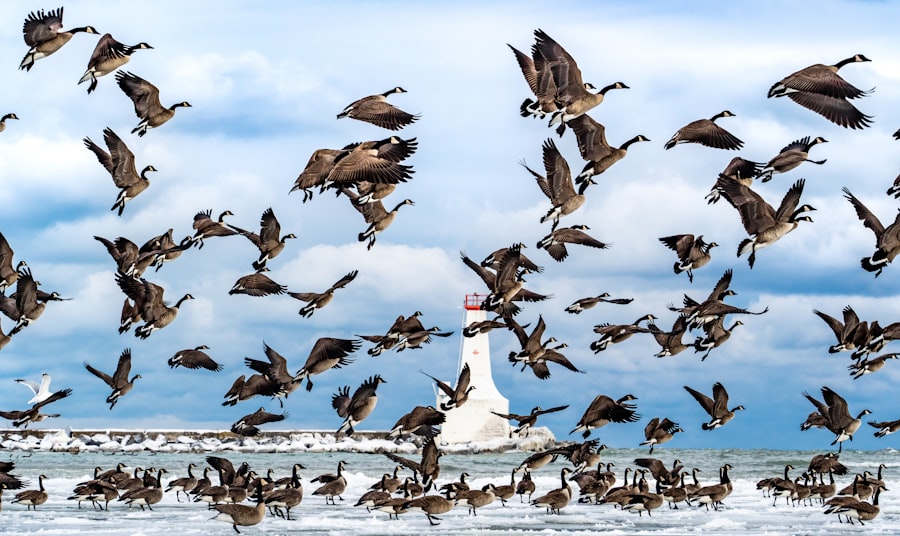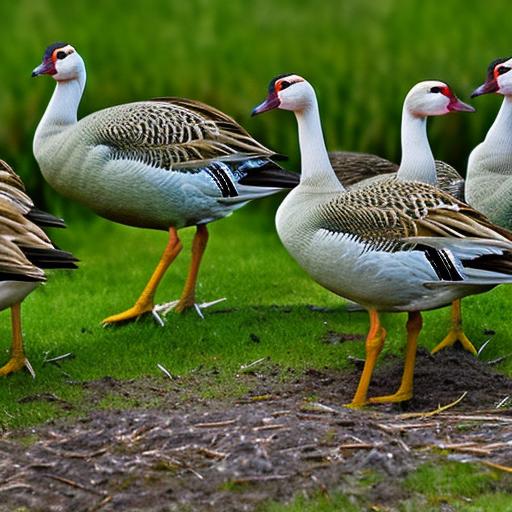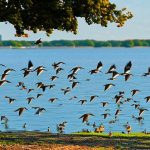Geese are beautiful and majestic creatures that are often found in parks, lakes, and other natural habitats. However, when these birds start to overpopulate an area, they can become a nuisance and cause a variety of problems for both humans and the environment. The issue of an overabundance of geese is a growing concern in many communities, as their presence can lead to environmental damage, health risks, and conflicts with humans. It is important to understand the impact of more geese and consider the legal and ethical considerations surrounding this issue. Additionally, strategies for addressing the problem, communicating with neighbors, and seeking community support are essential in finding a sustainable solution.
Key Takeaways
- Introduction to the Issue: Geese overpopulation can lead to environmental damage and health risks.
- Understanding the Impact of More Geese: Increased geese population can result in water pollution and damage to agricultural lands.
- Legal and Ethical Considerations: It is important to consider local laws and ethical implications when addressing the geese overpopulation issue.
- Strategies for Addressing the Issue: Implementing non-lethal methods such as habitat modification and repellents can help manage the geese population.
- Communicating with the Neighbor: Open and respectful communication with the neighbor is crucial in finding a mutually beneficial solution to the geese overpopulation issue.
- Seeking Community Support: Engaging the community in the issue and seeking their support can lead to more effective and sustainable solutions.
- Final Thoughts and Conclusion: Collaborative efforts and a holistic approach are essential in addressing the geese overpopulation issue for the benefit of the environment and the community.
Understanding the Impact of More Geese
An overpopulation of geese can have a significant impact on the environment. These birds are known to graze on grass and other vegetation, which can lead to the destruction of natural habitats and landscapes. This can result in soil erosion, loss of biodiversity, and damage to local ecosystems. Furthermore, the excessive droppings from geese can pollute water sources and contribute to the spread of harmful bacteria and parasites. This poses a threat to the health of humans and other wildlife in the area. In addition, the presence of large flocks of geese can lead to conflicts with other bird species, as they compete for resources such as food and nesting sites. Understanding the environmental impact of an overabundance of geese is crucial in developing effective strategies for managing their population.
On a social level, an increase in the number of geese can also lead to conflicts with humans. Geese are known to be territorial and aggressive, especially during their nesting season. This can pose a threat to public safety, particularly in areas where there is a high concentration of people, such as parks and residential neighborhoods. Additionally, the noise and mess created by large flocks of geese can disrupt the peaceful enjoyment of public spaces and lead to complaints from residents. It is important to consider the impact of more geese on the well-being and safety of the community as a whole.
Legal and Ethical Considerations
When addressing the issue of an overabundance of geese, it is important to consider both legal and ethical considerations. In many regions, geese are protected under wildlife conservation laws, which regulate the management and control of their population. This means that any actions taken to address the issue must comply with these laws and regulations. It is essential to work with local wildlife authorities and obtain the necessary permits before implementing any strategies for managing the geese population.
From an ethical standpoint, it is important to consider the well-being of the geese and their natural habitat. Any actions taken to control their population should be humane and respectful of their role in the ecosystem. It is also important to consider the potential impact of these actions on other wildlife species in the area. Finding a balance between protecting the environment and addressing the issues caused by an overabundance of geese is essential in developing a sustainable solution.
Strategies for Addressing the Issue
There are several strategies that can be implemented to address the issue of an overabundance of geese. One approach is habitat modification, which involves altering the landscape to make it less attractive to geese. This can include planting tall grasses or shrubs along shorelines, installing barriers to prevent access to certain areas, or using repellents to discourage geese from congregating in specific locations. Another strategy is population management, which may involve egg addling or oiling to prevent hatching, or culling under strict guidelines from wildlife authorities.
In addition, community education and outreach programs can help raise awareness about the impact of more geese and promote responsible behavior among residents. This can include providing information about the negative effects of feeding geese, as well as promoting alternative ways to enjoy public spaces without disturbing wildlife. By implementing a combination of these strategies, communities can work towards finding a sustainable solution to address the issue of an overabundance of geese.
Communicating with the Neighbor
When dealing with an overabundance of geese in a community, it is important to communicate effectively with neighbors to address their concerns and work towards a common solution. Open and respectful communication is key in building understanding and cooperation among residents. It is important to listen to the concerns of neighbors and involve them in the decision-making process when implementing strategies to manage the geese population.
One approach to communicating with neighbors is to organize community meetings or workshops where residents can voice their concerns and contribute ideas for addressing the issue. This can help foster a sense of community involvement and ownership in finding a solution. Additionally, providing regular updates on the progress of any strategies implemented can help keep neighbors informed and engaged in the process. By maintaining open lines of communication with neighbors, communities can work together towards finding a sustainable solution to address the issue of an overabundance of geese.
Seeking Community Support

Seeking community support is essential in addressing the issue of an overabundance of geese. Building partnerships with local organizations, businesses, and other stakeholders can help mobilize resources and expertise to implement effective strategies for managing the geese population. Engaging community members in volunteer programs or citizen science initiatives can also help raise awareness about the issue and promote responsible behavior towards wildlife.
One way to seek community support is to collaborate with local environmental groups or conservation organizations that have experience in managing wildlife populations. These organizations can provide valuable expertise and resources to support community-led initiatives aimed at addressing the issue of more geese. Additionally, reaching out to local businesses or landowners who may be directly affected by the presence of geese can help build a coalition of support for implementing sustainable solutions. By working together with the community, communities can leverage collective efforts to address the issue of an overabundance of geese.
Final Thoughts and Conclusion
In conclusion, the issue of an overabundance of geese is a complex challenge that requires careful consideration of its environmental, social, legal, and ethical implications. Understanding the impact of more geese on the environment and human communities is essential in developing effective strategies for managing their population. It is important to approach this issue with sensitivity towards wildlife conservation laws and ethical considerations, while also seeking community support and engaging in open communication with neighbors.
By implementing a combination of habitat modification, population management, community education, and outreach programs, communities can work towards finding a sustainable solution to address the issue of an overabundance of geese. Building partnerships with local organizations and seeking community support are crucial in mobilizing resources and expertise to implement these strategies effectively. By working together with neighbors and stakeholders, communities can find a balance between protecting the environment and addressing the issues caused by an overabundance of geese.
If your neighbor keeps getting more geese, you might want to consider creating a suitable coop for your own poultry. Poultry Wizard offers valuable insights on how to turn a shed into a chicken coop in their article “Turning a Shed into a Chicken Coop,” which can help you provide a safe and comfortable space for your chickens. Check out their tips and recommendations to ensure that your poultry are well taken care of.
FAQs
What are some common reasons why a neighbor might keep getting more geese?
Some common reasons why a neighbor might keep getting more geese include a love for animals, a desire to have a natural pest control solution for their property, or an interest in raising geese for their eggs or meat.
Are there any regulations or laws regarding keeping geese as pets?
Regulations and laws regarding keeping geese as pets can vary by location. It’s important to check with local authorities or animal control to understand any regulations or laws that may apply to keeping geese as pets in a specific area.
What are some potential challenges of keeping geese as pets?
Some potential challenges of keeping geese as pets include the need for adequate space, the noise they can produce, their potential to be aggressive, and the maintenance of their living environment.
How can someone address concerns with a neighbor who keeps getting more geese?
If someone has concerns about a neighbor who keeps getting more geese, it’s best to approach the neighbor in a respectful and friendly manner to discuss the concerns. Open communication and finding a mutually agreeable solution is often the best approach. If the concerns persist, it may be necessary to involve local authorities or animal control.
Meet Walter, the feathered-friend fanatic of Florida! Nestled in the sunshine state, Walter struts through life with his feathered companions, clucking his way to happiness. With a coop that’s fancier than a five-star hotel, he’s the Don Juan of the chicken world. When he’s not teaching his hens to do the cha-cha, you’ll find him in a heated debate with his prized rooster, Sir Clucks-a-Lot. Walter’s poultry passion is no yolk; he’s the sunny-side-up guy you never knew you needed in your flock of friends!







